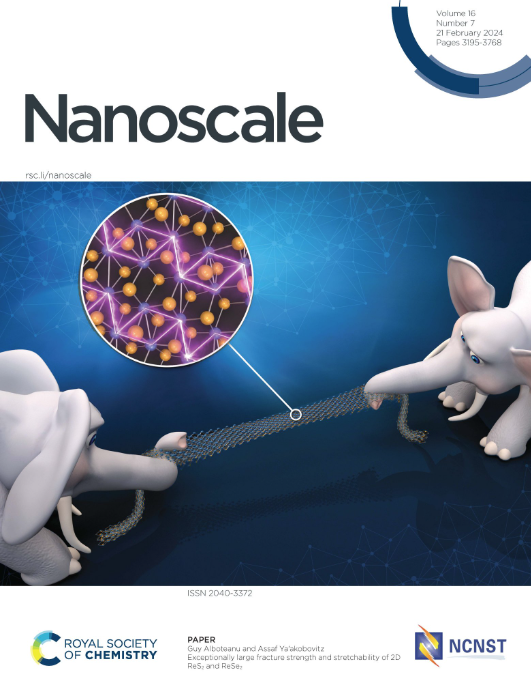Photoactivated defect engineering and nanostructure functionalization of MoS2 via a photochemical Fenton process
IF 5.8
3区 材料科学
Q1 CHEMISTRY, MULTIDISCIPLINARY
引用次数: 0
Abstract
Molybdenum disulfide (MoS2) is a promising 2D material for (photo)catalysis. However, its performance in (photo)catalytic applications is usually limited by a small amount of catalytically active defects. Here, we developed a novel large-scale, rapid, green, low-cost photoetching technique to transform multilayer MoS2 into a few-layer MoS2 with high defect density and simultaneous spatial functionalization of MoS2 with magnetic nanostructures using a photo-driven Fenton reaction. The photoetching process and resulting nanostructures were characterized by optical microscopy, atomic force microscopy, photoluminescence, and Raman spectroscopy. We elucidated the reaction mechanism driven by the Fenton reaction in which photogenerated charge carriers in MoS2 play a dual role: reducing Fe3+ and Cu2+ ions and generating hydrogen peroxide (H2O2) from water and dissolved O2. In this Fenton reaction, Fe2+ ions react with H2O2 to generate hydroxyl (˙OH) radicals, oxidizing MoS2 and forming metal oxide nanostructures at the reaction sites. This dual pathway, triggered by MoS2 photon absorption even at low-intensity illumination, ensures in situ generation of Fenton reactants (Fe2+ and H2O2), generating ˙OH, to achieve on-demand thinning and functionalization of MoS2 in a single step. Electron paramagnetic resonance spectroscopy confirmed the generation of ˙OH radicals as the main reactive oxygen species. This photochemical approach enables the photo-driven creation and growth of defects from submicrometer regions up to a dozen micrometers, both at native defects and predefined defective region seeds, by photochemical processing of MoS2 in FeCl3 and CuSO4 solutions. The presence of metal oxide nanostructures on MoS2 was verified using magnetic force microscopy, scanning electron microscopy with elemental mapping by energy dispersive X-ray spectroscopy and Raman spectroscopy. The simultaneous photoetching and metal oxide deposition improves the catalytic performance of MoS2 in the electrical hydrogen evolution reaction, evidenced by a potential shift from −0.7 V (graphite electrode) to −0.47 V (MoS2 sample photoetched in FeCl3 solution under a halogen lamp illumination) at a current density of 10 mA cm−2.

通过光化学 Fenton 工艺实现 MoS2 的光活化缺陷工程和纳米结构功能化
二硫化钼是一种很有前途的二维(光)催化材料。然而,其在(光)催化应用中的性能通常受到少量催化活性缺陷的限制。在这里,我们开发了一种新型的大规模、快速、绿色、低成本的光蚀刻技术,利用光驱动芬顿反应将多层MoS2转化为具有高缺陷密度的少层MoS2,并同时将MoS2与磁性纳米结构进行空间功能化。通过光学显微镜、原子力显微镜、光致发光和拉曼光谱对光刻过程和纳米结构进行了表征。我们阐明了由Fenton反应驱动的反应机理,在该反应中,MoS2中光生成的载流子发挥了双重作用:还原Fe3+和Cu2+离子,并从水和溶解的O2中生成过氧化氢(H2O2)。在Fenton反应中,Fe2+离子与H2O2反应生成羟基(˙OH)自由基,氧化MoS2,在反应位点形成金属氧化物纳米结构。这种双通道由低强度光照下的MoS2光子吸收触发,确保了Fenton反应物(Fe2+和H2O2)的原位生成,产生˙OH,从而在一个步骤中实现MoS2的按需稀释和功能化。电子顺磁共振谱证实了˙OH自由基是主要的活性氧。这种光化学方法通过在FeCl3和CuSO4溶液中对MoS2进行光化学处理,使得从亚微米区域到12微米区域的缺陷的光驱动产生和生长成为可能。利用磁力显微镜、扫描电镜、能量色散x射线能谱和拉曼光谱元素映射等方法验证了二硫化钼表面存在金属氧化物纳米结构。同时光蚀刻和金属氧化物沉积提高了MoS2在电析氢反应中的催化性能,在电流密度为10 mA cm−2时,电势从−0.7 V(石墨电极)转变为−0.47 V(在卤素灯照明下在FeCl3溶液中光蚀刻的MoS2样品)。
本文章由计算机程序翻译,如有差异,请以英文原文为准。
求助全文
约1分钟内获得全文
求助全文
来源期刊

Nanoscale
CHEMISTRY, MULTIDISCIPLINARY-NANOSCIENCE & NANOTECHNOLOGY
CiteScore
12.10
自引率
3.00%
发文量
1628
审稿时长
1.6 months
期刊介绍:
Nanoscale is a high-impact international journal, publishing high-quality research across nanoscience and nanotechnology. Nanoscale publishes a full mix of research articles on experimental and theoretical work, including reviews, communications, and full papers.Highly interdisciplinary, this journal appeals to scientists, researchers and professionals interested in nanoscience and nanotechnology, quantum materials and quantum technology, including the areas of physics, chemistry, biology, medicine, materials, energy/environment, information technology, detection science, healthcare and drug discovery, and electronics.
 求助内容:
求助内容: 应助结果提醒方式:
应助结果提醒方式:


